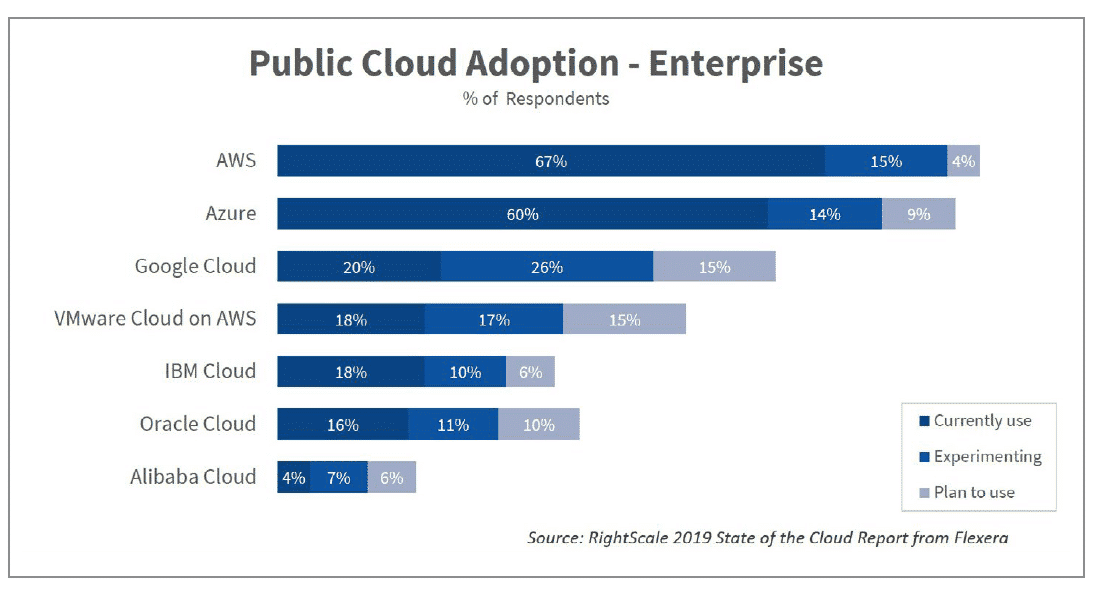Cloud migration has become one of the greatest buzzwords in our modern business world. For those who get it right, cloud migration has led to significant competitive advantage, increase in revenue, and modernization of their business. But while cloud technology isn’t new anymore, it’s still a concept that leaves many perplexed, and unable to capitalize on its inherent value.
Many business leaders hear the hype but aren’t sure if the cloud is right for them. After all, legacy systems and on-prem data centers have performed just fine. Why complicate things now?
The truth is, that the cloud is taking over, and soon the choice to migrate to the cloud could mean more than just a few extra dollars in your pocket. It could make or break your chances of survival. As a business leader in the digital age, power rests in your hands to steer your hypothetical ship to its ideal destination. The decisions you make, particularly around the adoption of cloud in the next several years, could make or break the future of your organization. Will you remain stagnant and reliant on outdated systems? Or will you take to the cloud and unlock your untapped potential? If you’re unsure about how to leverage the cloud for your organization or are wondering if the cloud is right altogether, allow us to offer some perspective.
What is a Cloud Migration?
What is it exactly about cloud migration that has enticed so many? For some, it’s the ability to get away from managing expensive hardware. For others, moving applications to the cloud allows them to save time or tap into unlimited storage. The Cloud has removed the limitations of hardware and legacy practices to open the door to infinite operating power, speed, and untapped potential.

In many cases, it may not be the cloud itself, but it has many potential applications that draw people In. Take, for example, NASA who used cloud technology to broadcast images of the Mars Curiosity Rover (pictured right) at otherwise unfathomable speeds. Or the Seattle Seahawks, who used data-driven decision-making to improve athlete recovery and performance and gain a competitive edge.
For many organizations, a migration to the cloud means millions of dollars of cost savings on outdated hardware and data centers. Or the increased time and resources to release cutting-edge innovations never before heard of. Whatever the pull, as of February 2018, roughly 77% of all enterprises had one or more portions of their computing in the cloud, and those numbers are only expected to rise.
With an increasing number of organizations investing in cloud technology, it strikes a tone of alarm for those who have yet to tap in. At the speed at which cloud adopters are progressing, and at the rate cloud technology is being adopted, it’s no question that those who fail to adopt are already falling behind. Staying on the cutting edge, and maintaining a competitive advantage demands that improvements be made, and the cloud has made a powerful case with the answer.
So, what is a cloud migration? In short, it’s the chance to transform your business, your opportunity, and your future. The question is, how will you use it to your advantage?
Different Types of Cloud Migrations
Though cloud migration has potential for everyone, not all clouds are the same. Organizations are finding unique ways to leverage the cloud with customized solutions. As a leader and decision-maker within IT, it is essential to know your options.
Public, Private, and Hybrid clouds are the three primary options chosen when initiating a move to the cloud, each valuable in different ways. Which cloud you choose will depend on what you hope to do with it.
Public Clouds are services built, managed, and provided by third parties. This includes public cloud providers like Google, IBM, Microsoft, and Amazon. In this model, the cloud provider owns and manages all infrastructure, services, processing power, etc. saving time and management costs for your business. Since cloud services are “shared” among thousands or even millions of cloud users, public cloud solutions often lack the customization and rigid privacy available through more private solutions. But don’t be fooled, public cloud services still offer plenty of flexibility and agility to get the job done, and countless organizations continue to flock to public providers for their many benefits, including:
- Easy set up
- No maintenance
- Infinite scalability
- Minimal downtime
- Minimal contracts (pay as you go)
Private Clouds are for those seeking a bit more customized and controlled cloud solutions. Organizations with rigid security protocols like Healthcare and Government agencies might prefer a private cloud. While they can still access the many benefits of a traditional public cloud, they now have complete control of everything from their network to their infrastructure, security, and hardware. While a private cloud still provides many benefits of the public cloud, it is often just as expensive to maintain as a traditional data center, as it requires in-house support to manage and maintain the required hardware. Private clouds may also be limited in their storage and processing power depending on how much the organization is willing to manage. But their many benefits keep customers coming back for more. Additional private cloud benefits include:
- Private connection for increased control
- Complete customization
- The ability to offer IaaS and PaaS services from within the cloud
Hybrid Clouds combine the qualities of private and public clouds, offering the perfect marriage of capabilities for clients who want the best of both worlds. Organizations who prefer the protection and control of a private cloud can get their customized solutions, while still having access to the unlimited scalability of public cloud services. A Hybrid cloud can also work for organizations with sensitive data, as they can pick and choose what data is used in the public cloud, and which data remains safely stored in their internal data center. This way, the business only pays for what it needs, rising and falling in its storage capacity as its traffic needs change. Hybrid Cloud benefits:
- Security of a private cloud
- Infinite scalability of a public cloud
- Only pay for what you need
Which Vendor is Right for My Cloud Migration?
Now that you know your way around the different cloud options, it’s time for the million-dollar question. Which cloud provider is best? While there are powerful solutions offered by top cloud vendors across the board, the right choice will largely depend on what you hope to do with it.
Amazon Web Services (AWS) - According to the 2019 State of the Cloud Report, Amazon Web Services leads the way in total enterprise usage. As a leader in the cloud space for more than a decade, AWS has the network and an expansive list of services to pack a powerful punch. However, some report that AWS isn’t the best option if you hope to integrate with your existing data center, and that hybrid clouds might be better suited for other providers. Users also complain of AWS’ confusing cost structure, which could play a big part in any major transformation. All things to consider when undertaking a cloud migration of any size.

Microsoft Azure – As a steadily growing competitor in the cloud space, Microsoft Azure continues to gain popularity, on the heels of AWS with high levels of enterprise cloud adoption. This service is often well appreciated by clients who already use Microsoft products, as they seem to integrate seamlessly with the platform, and can often be received for a discounted price. However, Azure’s late start in the cloud space has led to less refined resources and support, which could become frustrating for less experienced cloud users.
Google Cloud – As the creator of the world’s leading search engine, Google knows a thing or two about managing massive amounts of data. Google is reported to handle Big Data and large-scale projects particularly well. Google is also the birthplace of Kubernetes, setting the standard for containers that have now been accepted across the board. However, what it holds in processing power it seems to lack in product diversity. Users of this cloud have reported that there aren’t as many services to choose from, which could become frustrating as you dive headfirst into a cloud migration.
Benefits of Cloud Migration
Before deciding which path is right for you, it’s important to identify why you’re making the move to the cloud in the first place. While there are many obvious benefits to a cloud migration (cost savings, speed, scalability to name a few), consider these other cloud benefits that could impact you.
Faster Time to Market – When most people think of the cloud improving their speed, they’re most likely thinking of the time saved configuring and maintaining their systems. They’re not wrong! But what many fail to realize is that weeks or months saved on the front end of any project can also translate to faster results in the end. Faster development means faster time to market, giving cloud-centered organizations a distinct advantage. As Stephan Orban (Head of Strategy of Amazon Web Services) states in his book, Ahead in the Cloud, cloud technology gives you more time and energy to put into things that differentiate your business, rather than wasting it on things that don’t (like managing a data center). 3
Faster Revenue Growth – As time to market speeds up, so does the ability to grow revenue at a faster pace. According to a study by Dell, “Companies that invest in big data, cloud, mobility, and security enjoy up to 53% faster growth than their competitors.” That means, in the time it takes your competitor to complete a project on an outdated legacy system, you could already be steps ahead of the game.
"Companies that invest in big data, cloud, mobility, and security enjoy up to 53% faster growth than their competitors."
Increased Innovation – The cloud is pushing technology to places it's never gone before. As we see with NASA and the Mars Curiosity Rover, cloud processing power allowed engineers to transmit images at speeds previously unheard of. With only a limited window of time to communicate with the rover, this capability gave NASA engineers more time to plan Curiosity’s route for the day and explore new areas of the planet like never before. You don’t have to be a rocket scientist for the cloud to work for you, too. The cloud’s incredible capacity has unlocked a new dimension of applications we haven’t even discovered yet. What innovations have you been dreaming up? With the help of the cloud, your next big idea could become a life-altering reality. Now that’s something outdated hardware just simply can’t match.

Increased Employee Output – Can you imagine a world where your developers could spend their time—developing? In the past, legacy systems have required hours, days, or even weeks spent on configuration before development even begins. With the help of cloud capabilities like Serverless and Infrastructure as Code (IaC), the cloud can help you regain your greatest asset: your skilled employees. Imagine the possibilities when your team can spend more time developing than simply configuring, reconfiguring, and maintaining systems every time a project ramps up. Call us crazy, but we think this is an upgrade they might just appreciate, too.
Insights – Competing in a data-driven world requires data-driven decision-making across every aspect of a business. However, many organizations cannot analyze the company on a grand scale and may even use different data points across departments and teams. Cloud technology lets us take a big-picture look at the business, to remove inconsistencies and analyze everything from sales and revenue to internal spending and performance. Sunny Delight used cloud technology to make data-driven decisions in their business, ultimately boosting their profits by roughly $2 million and cutting annual staffing costs by $195,000. What kind of financial impact could the right data offer you?
Full-Scale Business Transformation – Cloud success across any of these areas could be a welcome improvement for a business. But Veracity cloud experts have found that the improvements usually don’t stop there. In many cases, a move to the cloud can set off a positive domino effect across other areas of your business. Increased time to delivery, focus, and development capacity can often lead to improvements in other areas like customer service, internal operations, and quality control.
Common Cloud Migration Mistakes
While the idea of cloud migration isn’t new for everyone, claiming its many advantages remains a complex challenge. In many instances, a move to the cloud might be a bit more involved than you think. As we learn from this cartoon, throwing around fancy cloud lingo is not enough to cut it.

Image from Dilbert.com
The reality is, the cloud has unlocked new technology. Innovations, capabilities, and speed that for many, have never been tapped into before, and few organizations have the manpower experienced enough to manage it. Fortunately, with a few tips and the guidance of a trusted partner, you could soon be writing your own cloud success story.
If your cloud migration attempts don’t seem to be stacking up, here are a few common mistakes you might want to consider.
- Not Aligning Your Cloud Strategy with Business Objectives - Don't let the buzz around “cloud migration” trick you into jumping in too soon. Before you begin working in the cloud, it’s crucial to take time to map out how a cloud migration will contribute to your ultimate business objectives. You may realize that you need a more robust cloud offering than you bargained for. Or, perhaps you’ll realize that you only need a few simple tools to move forward. Aligning your cloud strategy with your business objectives will not only help you select the right cloud for you but also provide lasting value once your migration is complete. After all, the purpose isn’t to just “get to the cloud.” The right plan can help you use the cloud to create lasting value over time and achieve your ultimate objectives.
- Assuming All Clouds are the Same - As we learned from our cloud vendor comparison above, not all clouds are created equal. Depending on the needs of your organization, you might be better suited to choosing one specific provider over another. Making the wrong decision on which cloud to dive into could mean limited capabilities and frustration down the road. Sit down with a trusted partner to discuss your options and determine which cloud is right for you!
- Going it Alone – When first stepping into the cloud space, it can feel intense and overwhelming, and the reality is, that most organizations don’t have the right personnel to get it done. A trusted partner can keep you from making rookie cloud mistakes so you can focus on pushing your business ahead. The right partner can help you make educated cloud decisions, evaluate your options, and provide the expertise to see your migration through. You wouldn’t go skydiving in the real world without an instructor. Why should a jump into the virtual cloud be any different?
How to Begin Your Cloud Migration
Deciding to jump to the cloud is the first step for any successful migration. But where do you go from here? If you want to make the most of your migration for your business, here are a few things to consider.
- A powerful leader can make a big difference. While not all organizations will jump for joy at the thought of cloud migration, the right leader can set the tone. By being completely bought in, instilling confidence, and setting a positive example, the right leader can be a catalyst for massive change company-wide. Stay disciplined, driven, and focused on the business outcomes you’d like to achieve, and soon your teams will follow suit. 3
- Don't think you have to do it all at once. Cloud migrations take time and are rarely done all at once! Plus, your teams will likely feel overwhelmed with taking on so many new processes, practices, and architecture in such a short amount of time. Most companies will have applications that are easier or harder to move to a cloud environment. Once you identify which applications might be best suited for the cloud, start there. Once your team has the chance to gain experience and build confidence, move on to more complicated tasks. Pacing yourself will help you take a steady deliberate approach to the cloud and help prevent burnout along the way.3
- Find a trusted cloud partner. The success of your cloud migration will be greatly impacted by the guidance you accept along the way. By finding someone with experience and the expertise to complete a migration, you can receive valuable training, strategic direction, and the help you need for a successful cloud migration. Find someone as equally invested as you are in the success of your business, and watch your potential be taken to new heights.
Ready or not, cloud technology is quickly differentiating between industry leaders and those who get left behind. The right cloud migration can not only help you keep up but also offer the capability to surpass your competition. If you’re ready to leap, our experts can help. Set up a free hour with a cloud expert to find out how you can take your business to the cloud.
Sources:
Ahead in the cloud
1. "12 Benefits of Cloud Computing," Salesforce (blog), September 6, 2019, https://www.salesforce.com/products/platform/best-practices/benefits-of-cloud-computing/#
2. Columbus, Louis. "State of Enterprise Cloud Computing, 2018," Forbes.com, September 12, 2019. https://www.forbes.com/sites/louiscolumbus/2018/08/30/state-of-enterprise-cloud-computing-2018/#66beb8ec265e
3. Orban, Stephen. Ahead in the Cloud. South Carolina: CreateSpace Independent Publishing Platform, 2017.
4. "What is a Hybrid Cloud?" Microsoft Azure (blog), September 10, 2019, https://azure.microsoft.com/en-us/overview/what-is-hybrid-cloud-computing/
5. "What is a Private Cloud?" Microsoft Azure (blog), September 10, 2019, https://azure.microsoft.com/en-us/overview/what-is-a-private-cloud/
Subscribe to our blog
Related Posts
On-Prem to Google Cloud: Cloud Migration in 5 Steps
Picking a cloud provider is never an easy task. As we round out the last of our Big 3 series on cloud migration, it’s clear that there is a never-ending list of features, products, and unique business needs to consider at every turn. However, while the search for the right cloud provider(s) might feel overwhelming, a focus on the “why” behind cloud migration (rather than a strict focus on tools and solutions) is key to staying on track.
-
8 min read
- Dec 6, 2019 2:41:26 PM
On-Prem to Azure: A Guide to Cloud Migration
Are you considering a move to the cloud? In this article, we'll take you from on-prem to Microsoft Azure, walking step-by-step through the cloud migration process, and offer special considerations to keep in mind as you begin your cloud journey.
-
9 min read
- Feb 23, 2022 2:40:00 PM
What is Kubernetes?
We can’t talk about Digital Transformations or Cloud-Native Security without talking about Kubernetes.
-
3 min read
- Sep 22, 2021 8:41:58 AM


